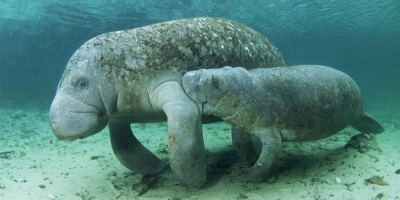
Manatees constantly grow molars, but are incapable of biting anyone. These gentle marine mammals eat seagrass many hours a day. The sand granules eaten along with the grass wear down their teeth which eventually fall off. As the front teeth fall off the molars at the back get pushed forward, which is why they are called “marching molars.”
Manatees were once thought to be mermaids by early sailors, including Christopher Columbus, who described the “mermaids” as less beautiful than he imagined with masculine faces. In fact, manatees belong to the order Sirenia, which derives its name from the sirens (or mermaids) of Greek mythology. A common myth regarding manatees is they are an invasive species in Florida imported to control exotic aquatic plants. Florida manatees are in fact native to the United States, as seen in both the fossil records and in Native American sites. Depending on the time of year they can be frequently found in Florida, Alabama, and Georgia. On very rare occasions Florida manatees have been seen as far north as Massachusetts!
Manatees use their tails in an up and down motion to propel themselves forward. Strong swimmers, they are capable of reaching speeds of 15 miles per hour in short bursts. Manatees rest from 2 to 12 hours a day either suspended near the water’s surface or lying on the bottom, usually for several hours at a time.
While most people tend to see many manatees gathered together at winter warm-water sites, during the rest of the year these animals are semi-social as they travel around the state’s waterways in search of food, mates or places to rest. Except for cow/calf pairs and small mating herds, manatees do not need to travel together although they do socialize when other manatees are encountered.
Manatees reach sexual maturity in 3-5 years (females) and 5-7 years (males) and may live over 65 years in captivity. Gestation is approximately 13 months and usually one calf is born. The calf may stay with its mother (cow) for up to 2 years. Male manatees (bulls) are not part of the family unit. Bulls will leave a cow alone after her breeding period is over. Of the wild manatees that reach adulthood, only about half are expected to survive into their early 20s.
Picture Credit : Google




